 |
|
|
 |
| |
 |
| |
| Hotels in Bikaner |
|
|
|
 |
 |
Around Bikaner
Devi Kund (8 Km)
Gajner Wildlife Sanctuary (32 Km)
Deshnoke Temple (30 Km)
Bhandeshwar & Sandeshwar Temples
Kalibanga
Camel Breeding Farms (8 Km) |
| View More... |
 |
|
| |
|
 |
|
 |
| |
| Bikaner, situated in the northern part of Rajasthan, was founded in 1486 AD by the Rathore prince, Rao Bikaji, hence the name Bikaner. |
| |
Bikaji was son of Rao Jodhaji who had asked his son to establish a kingdom of his own. The challenge was accepted and Bikaji choose the wild country 'Jangaldesh' as his territory and thus the city of Bikaner came into existence. A seven-kilometres wall with five entrances was built to protect the city from vagaries of the desert and any external aggression. The city flourished as an important trade centre between Gujarat seaports and West Asian countries.
The unbroken line of descendants of Bikaji ruled Bikaner till India got Independence. Bikaner is also called the camel country, being renowned for the best riding camels in the world. It is also the birthplace of the world famous Bikaneri bhujia and namkeen (a salted snack made of lentils). The Camel Festival held every year is famous all over the globe. Bikaner has many magnificent buildings made of Reddish Pink sandstone that transcends the surrounding barren wilderness |
 |
Bikaner at a glanceArea: 165.75 sq. km
Population: About 4 lakhs people reside in this historic city.
Altitude: 237 metres above sea level
Languages: Rajasthani, Hindi & English
STD Code: 0151
Founded By: Rao Bikaji
Best time to visit: October to March
|
 |
|
| How to Reach |
 |
 |
 |
By Air:
The nearest airport is Jodhpur 240 kms |
By Train:
The Indian Railways connects Bikaner with cities like Delhi, Calcutta, Agra, Jaipur, Allahabad etc. The gorgeous 'Palace on wheels' also covers Bikaner in its eight-day tour of Rajasthan. |
By Road:
Though the unfriendly desert sands surround Bikaner but the city is well connected by roads. There are local and inter-state bus services for Bikaner. |
|
| |
| Places of Interest |
| |
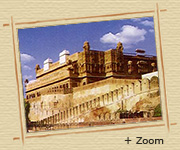 Junagarh Fort Junagarh Fort
The Junagarh Fort, built by Rai Singh between 1588 and 1593, has a 986-metre-long wall with 37 bastions, a moat and two entrances. Situated at a height of above seven hundred feet above sea level, it towers over the city and can be seen from a distance. The fort and its palaces are profusely decorated with magnificent stone carvings. The major buildings within the fort include the Anup Mahal, Diwan-e-Khas, Hawa Mahal, Badal Mahal, Chandra Mahal, Phool Mahal, Rang Mahal, Dungar Mahal, and Ganga Mahal. The Chandra Mahal has remarkable frescoes. Beautiful mirror work adorns the walls of Phool Mahal while golden pen work decorates the Anup Mahal.
|
| |
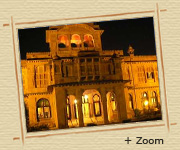 Lalgarh Palace Lalgarh Palace
Built by Maharaja Ganga Singh in memory of his father, the Lalgarh Palace is situated 3 km north of Bikaner city. Designed by Sir Swinton Jacob, the palace is quite imposing with overhanging balconies and delicate latticework. Peacocks and blooming bougainvillea in the garden welcome the visitor to the palace. The palace houses a museum now and three different heritage hotels.
|
| |
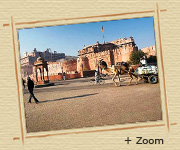 Ganga Golden Jubilee Museum Ganga Golden Jubilee Museum
Established near the Lalgarh Palace in 1937 on the eve of the Golden Jubilee celebrations of Maharaja Ganga Singh this Museum now run by the Government of Rajasthan, was shifted to a new building in the Civil Lines in 1954. Some principal sections of the museum are Maharaja Ganga Singh Memorial, local Arts and Crafts, History• Sculpture, Terracotta and Bronzes Armoury, Miniature Paintings and Folk-Arts, Dr. L.P. Tessitori Memorial Section, Lithoprints of the British Interpretation of the war of Independence 1857.
|
| |
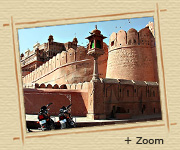 Shri Sadul Museum Shri Sadul Museum
To preserve the glory of the yesteryears of Rajasthan in general and Bikaner in particular, a part of the Lalgarh Palace has been converted into a museum. Known as the Sadul Museum, it covers the entire first floor of the palace. Some of the well-preserved old photographs and trophies of wildlife collected by the royalty have been housed here.
|
| |
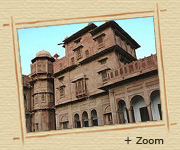 Fort Museum Fort Museum
The Ganga Mahal was Maharaja Ganga Singh's contribution to Junagarh Fort in the early 20th century. This pink sandstone hall, having walls carved with delicate tracery and scrollwork, today houses part of the fort museum. From jade-handled daggers to ivory-inlaid muskets, an exotic array of antique Rajput weaponry is on display here. Other important objects include a pair of drums belonging to Jambhoji - the saint who predicted the foundation of the dynasty by Rao Bika for 450 years. Photographs and items of personal use by Maharaja Ganga Singh and miniatures are also on view.
|
| |
|
|




